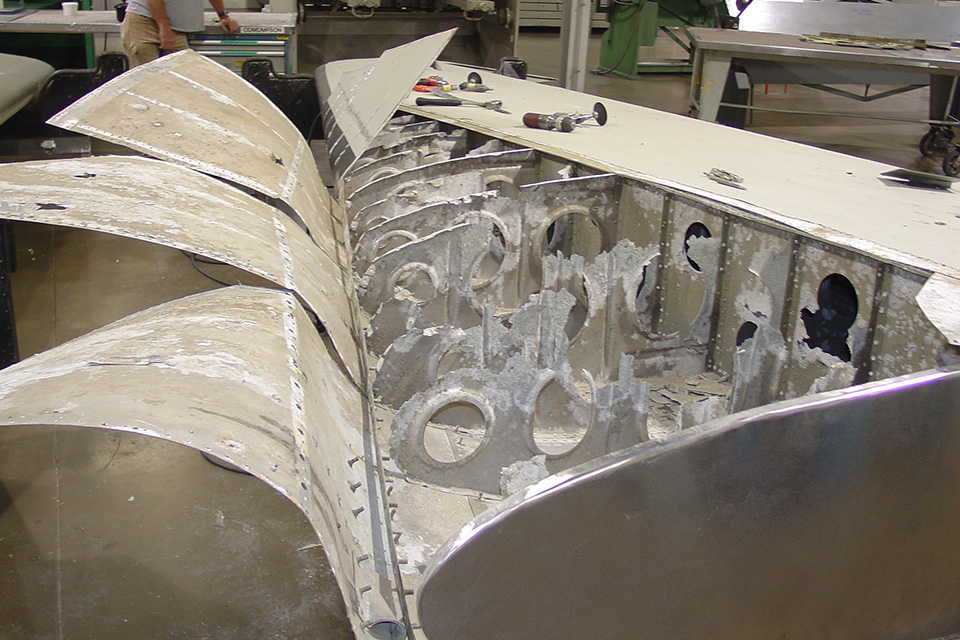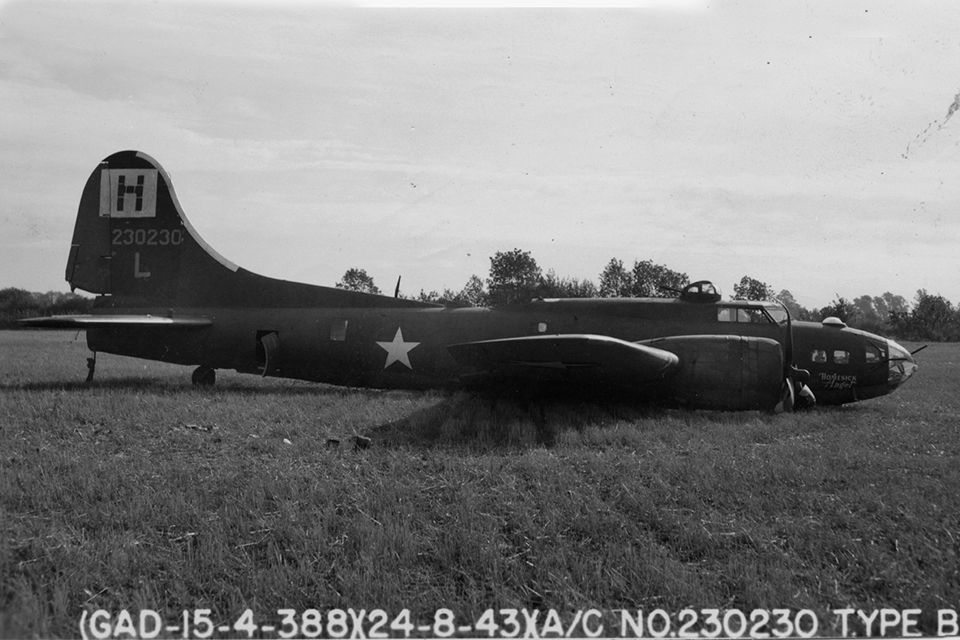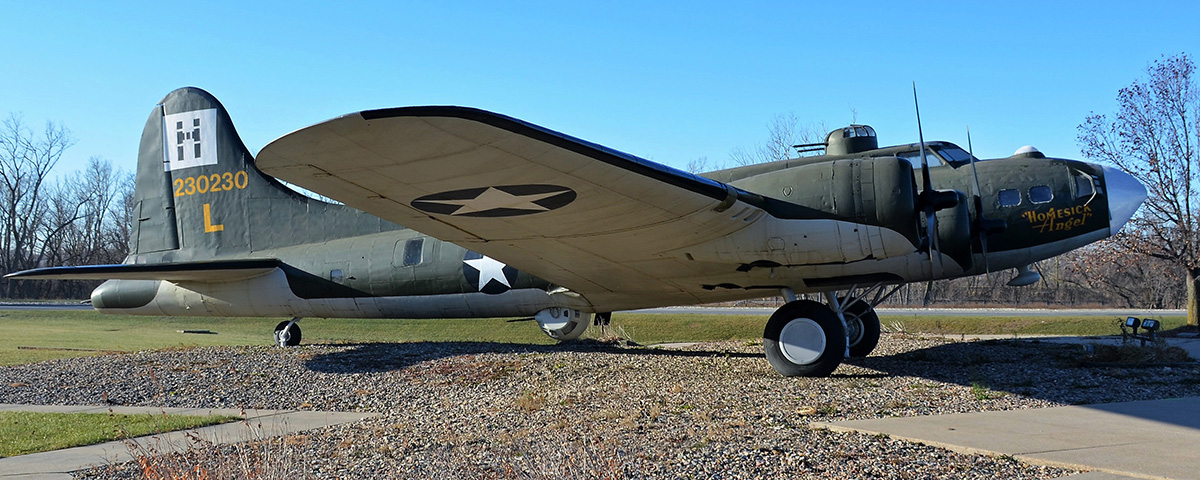The Midwestern gate guard stands in for a storied six-mission bomber.
The Boeing B-17F that serves as a gate guard at Offutt Air Force Base never saw combat during World War II, and narrowly missed out on a glamorous Hollywood career as well. The Flying Fortress recently gained new luster, however, thanks to a borrowed name and a sorely needed facelift befitting a former queen of the skies.
Delivered to the Army Air Forces on May 26, 1943, from the Douglas Aircraft Company’s plant at Long Beach, Calif., B-17F serial no. 42-3374 was first assigned to the 373rd Sub Depot at Dyersburg, Tenn. On September 8, 1944, the bomber was placed in “Class 26,” which meant it was on nonflying status and available for technical school training.
When WWII ended, the Flying Fortress went to the Metro-Goldwyn-Mayer Studios at Culver City, Calif., where it was supposed to have played a starring role in a war film tentatively titled Footprints in the Sky. Alas, the motion picture was never made, and for years 42-3374 was relegated to obscurity in a storage area on MGM’s back lot.
During the 1960s the studio brass decided to give away the B-17 along with all the other warbirds they had on hand to make way for a corporate hotel. When Edward Maloney from the Planes of Fame Air Museum learned of MGM’s giveaway offer, he had the Fort disassembled and trucked to Chino, Calif., where the bomber was put on display outdoors with its landing gear raised, so the fuselage rested on the sandy soil.
In 1981 Maloney traded the Flying Fortress to the Beale Air Force Base Museum, near Marysville, in northern California, where it was again displayed outdoors, but this time with its gear extended for the first time in many years. Meanwhile officials at the National Air and Space Museum learned that the aircraft, an “F” model, had been fitted with an “E” model nose, glazing over the bombardier’s compartment. A trade was worked out, and the correct glazing was installed on 42-3374.
In 1989 General John T. Chain Jr., then commander in chief of Strategic Air Command, headquartered at Offutt, ordered the B-17 brought to SAC’s home base at Bellevue, Neb. The aging warbird would have a new mission, serving as a gate guard.
When Strategic Air Command was officially disbanded on June 1, 1992, it became part of Air Combat Command. Number 42-3374 joined a second Flying Fortress displayed at the base, part of Offutt’s outdoor Strategic Aerospace Museum.
In 1998 all the aircraft from the Bellevue museum’s collection were transferred to the new Strategic Air and Space Museum’s $33 million facility at Ashland, Neb. According to Walter Chapman, a civilian aircraft structural repairman from the 55th Maintenance Squadron at Offutt, no. 42-3374 arrived on 14 pallets in the hold of a Lockheed C-5A Galaxy. He recalled that the WWII bomber was in poor condition at that point, the result of being exhibited outdoors for nearly four decades. Chapman, who served as the unofficial project leader for the restoration effort, initially estimated it would take more than two years to bring the aircraft back to first-class condition.

That proposed two-year schedule was shortened when General Chain indicated he wanted the B-17 ready for display within nine months. Chapman recalled, “Our plan then changed to make the aircraft look good on the outside…in the time we were given.”
Since 1989 the bomber has been inspected annually, with some preventative maintenance carried out each year. Most of the problems have been the result of exposure to harsh Midwestern weather, as well as birds nesting inside the plane. “The damage is not due to neglect,” said Bob Dean, a maintenance squadron fabrication section chief, who explained that when water gets inside, it corrodes the metal. “Over time the aluminum deteriorates back to its original state, and if the aircraft is not maintained, it basically rots,” he said.
The nearly year-long renovation initiated in 2008 is the most extensive overhaul the aging bomber has seen in the 18 years it’s been in Nebraska. In November and December 2008, each of the almost 300-pound horizontal stabilizers was removed from the aft fuselage and brought inside, where they were 100 percent rebuilt. According to Chapman and Gary Littlefield, another maintenance technician, those sections required almost all new interior ribs, and the outer surfaces had to be reskinned. Originally covered with fabric, the elevators are now clad with aluminum. After several months’ work, the newly rebuilt sections were reinstalled on the B-17’s tail.
Next came removing and repairing sections of the wings outboard of the engines— each piece weighing in at more than 750 pounds. When the old aluminum skin was peeled off, it revealed that most of the stringers and ribs were heavily corroded and would have to be replaced. “They built them pretty stout, so they could take a lot of damage,” Chapman pointed out, referring to the outer wing panels. But he also noted that the original metal had never been painted or coated with a preservative, and as a result the aluminum had corroded quickly. “When we opened up some sections, we found just powder,” he recalled.
While the wing panels were being rebuilt, another crew began inspecting and repairing corroded portions of the fuselage. The entire aircraft then had to be sanded in preparation for a coat of environmentally friendly olive drab paint on the topside and neutral gray on the underside.
Offutt’s B-17F can claim a dual identity of sorts. The name now painted on its nose is Homesick Angel. The Flying Fortress that originally bore that name was a B-17G-75-VE, serial no. 42-30230, which at one point was known as Happy Warrior—one of 10 bombers attached to the Eighth Air Force’s 388th Bomb Group, 562nd Bomb Squadron, in 1944. According to Roger Freeman’s book B-17: Fortress at War, it served as a staff aircraft, used by crews when the Forts they usually flew had been pulled out of service due to battle damage or mechanical problems.
On August 17, 1944, 2nd Lt. Henry Rogers and his crew were assigned to the Eighth Air Force’s first shuttle mission, targeting the Messerschmitt factory at Regensburg, Germany. After the attack, plans called for the formation to fly on to North Africa, so the crews could refuel and rest before returning to England. But the week before, during an August 12 sortie, Rogers’ regularly assigned aircraft, Wailuiku Maui, had been forced to return to base due to engine trouble. Rogers and his crew were given 42-30230, Homesick Angel, for the August 17 mission.
While flying over the Mediterranean after bombing Regensburg, Rogers, his co-pilot, navigator and engineer determined that they were running low on fuel. They decided to leave the formation and fly a more direct route to reach Bone, Tunisia. As a result, Home sick Angel arrived at the Tunisian airfield before the rest of the bombers. They were met by a contingent of high-ranking officers who were expecting to see the mission leader, Brig. Gen. Curtis LeMay, step out of the plane. The officials seemed some what startled to see Lieutenant Rogers crawl out of the bomber’s hatch to greet them instead.

On August 24, Rogers was with a formation that bombed a German airfield at Bordeaux, France. While crossing the English Channel, Angel’s crew again saw that their plane was dangerously low on fuel. Just as it entered the landing pattern at their home base, all four engines stopped running. Rogers safely guided the bomber down to a belly landing, during which none of the crew was injured. One account stated that when emergency personnel arrived at the crash scene, all the crewmen were calmly feasting on watermelons they had brought with them from North Africa. But the plane was declared a total loss and had to be written off after only six missions.
Offutt’s own Homesick Angel has admittedly led a less active life than its namesake. Since restoration was completed in June 2009, however, the Flying Fortress has proudly guarded Offutt’s south gate, representing one of WWII’s most iconic aircraft.
Originally published in the November 2009 issue of Aviation History. To subscribe, click here.





